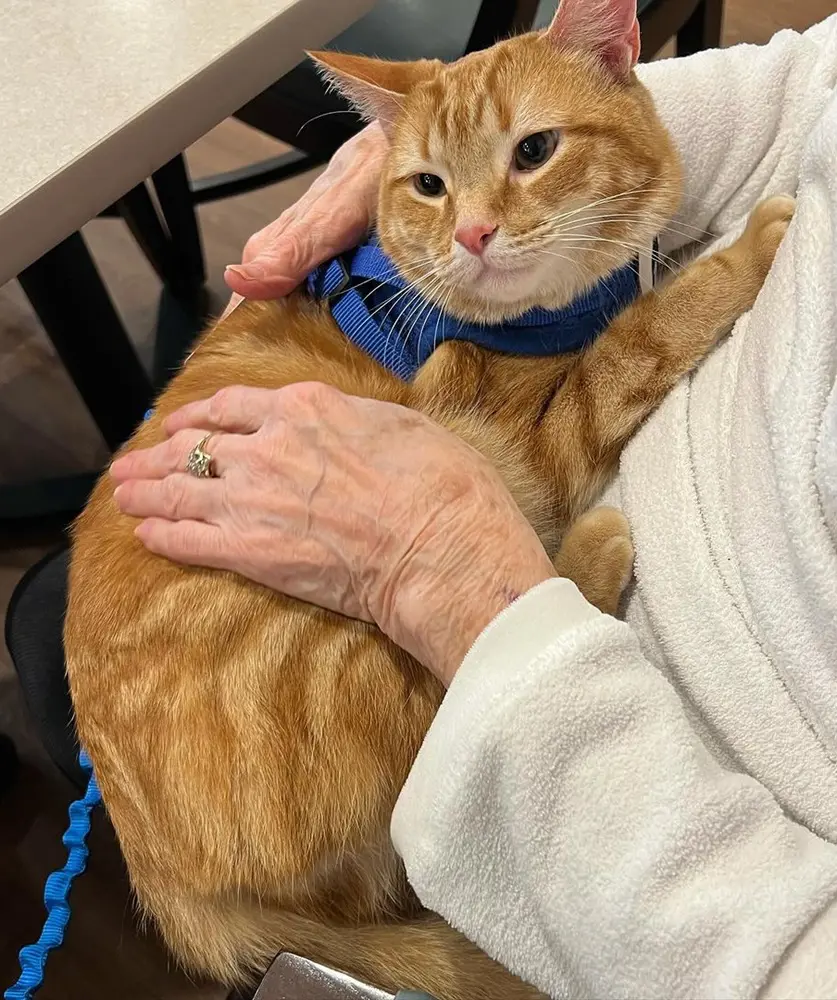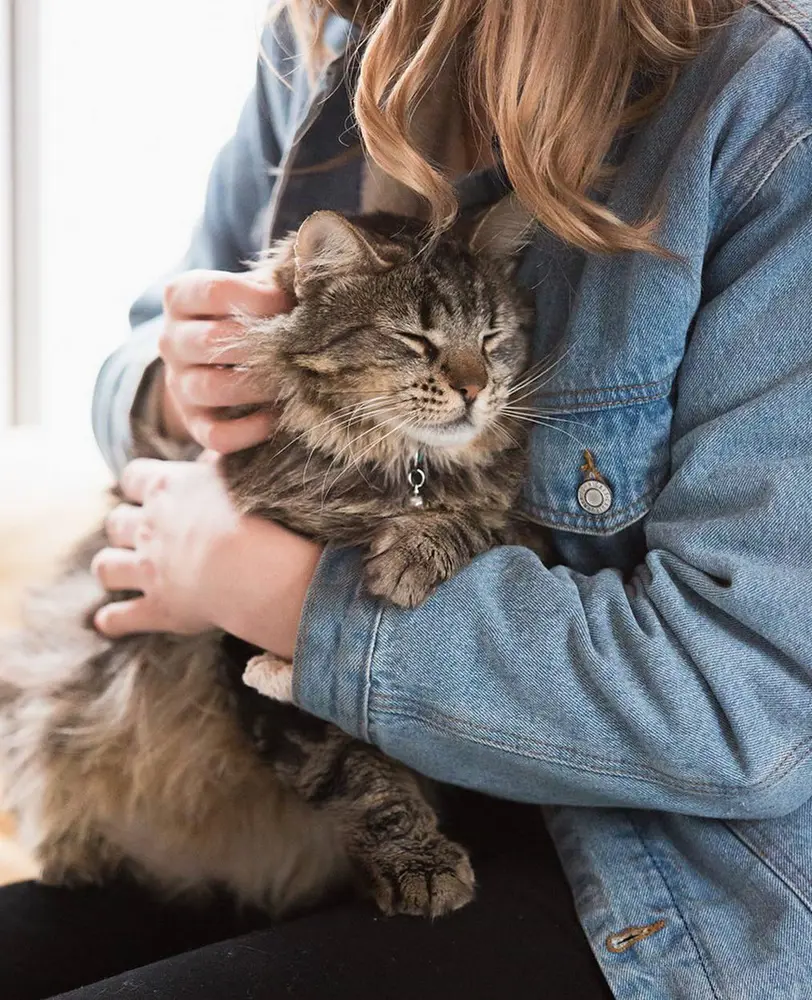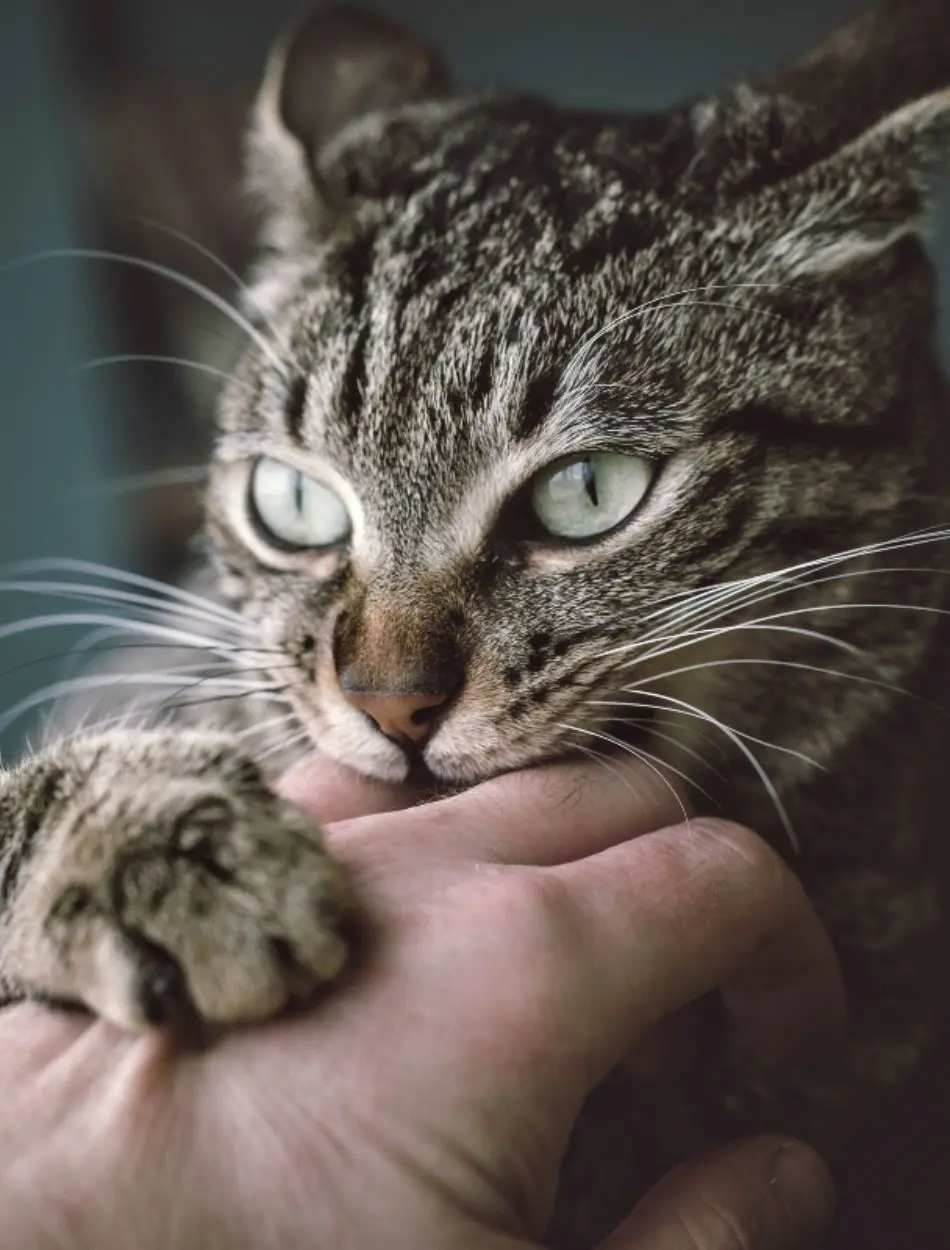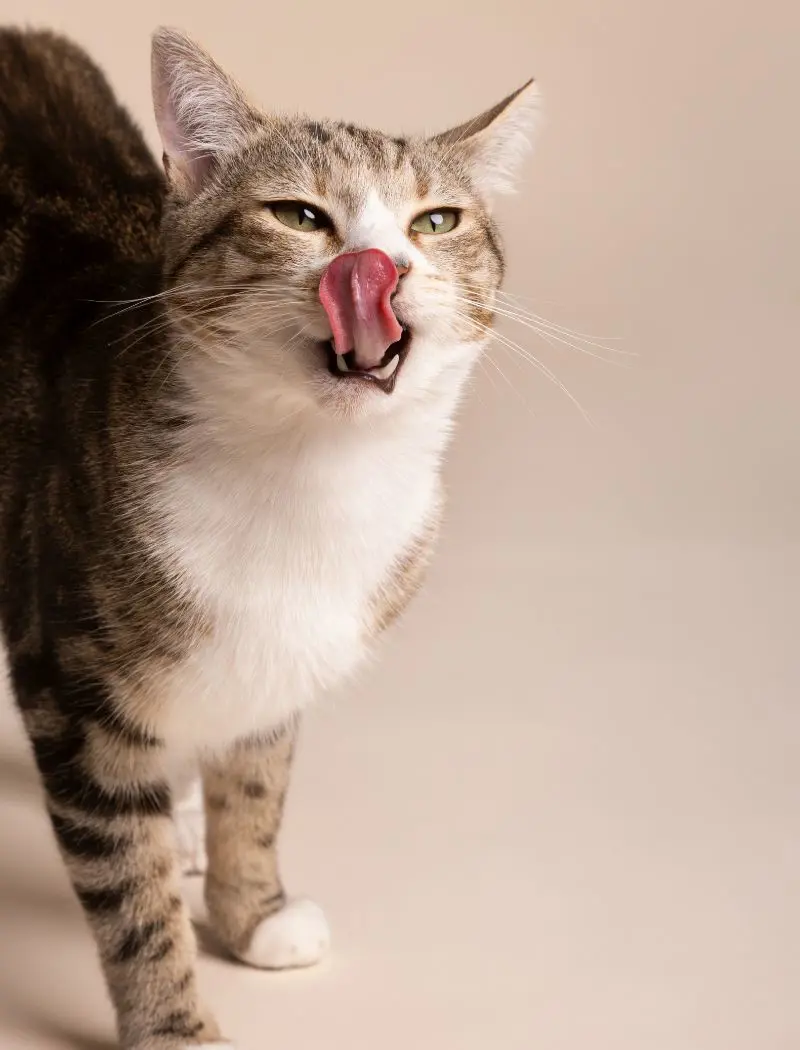What Are Therapy Cat And What Do They Do?

Cats are often misunderstood to be cold and distant animals who are only using humans for food. However, these stereotypes overrepresent a tiny fraction of cats and overlook their many positive aspects.
In reality, these felines tend to adapt their behavior, depending on the human they are dealing with. They can be as playful and affectionate as a dog with their families and loved ones. Recognizing this quality in cats, therapists, and health care professionals all over have begun using these gentle felines in therapy.
What Are Therapy Cats?
Therapy cats are specially trained felines that provide comfort and emotional support to people in various settings like hospitals, nursing homes, and schools. Unlike service animals, therapy cats do not perform specific tasks but help alleviate anxiety, stress, and depression through their calming presence.
The rise of therapy cats as a mental health service reflects a growing recognition of the therapeutic benefits of animal-assisted therapy. Their gentle demeanor and purring can soothe nerves, reduce stress, and promote relaxation.
Therapeutic cats mostly appeal to individuals who prefer the quiet companionship of a cat over a dog, including seniors, children, and those with sensory sensitivities or social anxiety.
Do Cats Make Good Therapy Animals?

Cats are capable of becoming effective therapy companions due to their calm nature and strong emotional attachments with humans. Their purring is known to have a soothing effect, which can help reduce anxiety and promote relaxation.
Similarly, cats are relatively smaller than other service animals. Their small size makes them ideal for individuals who may be overwhelmed by larger energetic animals.
However, cats as therapy animals may have limitations. They are generally more independent than dogs and may not always be as responsive to training or as willing to engage with unfamiliar people. Their effectiveness largely depends on their temperament, as some cats are more social and adaptable than others.
Benefits of Therapy Cats
- Cats are low-maintenance and require less space than larger animals.
- Their purring has a proven calming effect, helping to reduce stress and anxiety.
- Cats are quiet and less likely to overwhelm individuals in therapy settings.
Problems with Therapy Cats
- Cats can be more aloof and less predictable in their behavior than dogs.
- They may not tolerate unfamiliar environments or people as well as some other animals.
- Some people may have allergies to cats, limiting their use as therapy animals.
What Does A Therapy Cat Do?
Before understanding the responsibilities of a therapy, you should know the distinction between a therapy and a service animal. Unlike a service animal, therapy cats are not trained to perform specific tasks for a person with a disability.
Instead, their role is to provide general comfort and enhance emotional well-being. Therapy animals are not protected under the Americans with Disabilities Act (ADA) and do not have the same public access rights as service animals.
These are considered to be the major services provided by a therapy cat:
Emotional Support
Therapy cats provide invaluable emotional support to individuals dealing with mental health issues like depression, anxiety, and PTSD. Their non-judgmental presence can create a safe and comforting environment for those who feel isolated or overwhelmed by their emotions.
Additionally, petting a cat or having a cat sit on a lap can release oxytocin, a hormone associated with bonding and relaxation. The purring vibrations are also believed to have therapeutic effects.
Stress and Anxiety Reduction
The rhythmic act of petting a cat is known to lower heart rates and reduce blood pressure. This physical interaction provides calming sensory feedback, helping to alleviate feelings of anxiety and panic.
In therapy sessions, a cat's presence can provide a grounding effect as individuals can focus on the comforting tactile sensations of the cat's fur rather than their stressors. This can be particularly beneficial for individuals with anxiety disorders or those who experience panic attacks.
Elderly Companionship
Therapy cats provide companionship to elderly individuals, particularly those in nursing homes or assisted living facilities. Many older adults experience loneliness and isolation, especially if separated from family or friends.
A therapy cat can offer a sense of companionship and routine to seniors who have lost loved ones or have limited social interactions. Seniors are encouraged to gently pet, talk to, or play with the cats. It helps improve motor skills and encourages social interaction with staff and other residents. Caring for or spending time with a cat can provide a sense of purpose and daily structure to senior citizens.
Therapeutic Interaction
In educational settings, therapy cats are used to help children with learning disabilities, ADHD, and autism spectrum disorders. For children who struggle with reading or other tasks, reading aloud to a non-judgmental listener like a therapy cat can boost confidence. The cat's presence can also teach empathy, patience, and nurturing behaviors.
Similarly, in healthcare, therapy cats can assist in pain management and recovery by providing distraction and comfort to patients. Their company has been shown to reduce the perception of pain and discomfort. The calming effect of felines can also help improve mood and reduce the need for pain medications.
Training To Become A Therapy Cat

Training a cat to become a therapy animal involves modifying its emotional and behavioral traits. Unlike dogs, cats naturally possess a more independent nature, so the training focuses on making them comfortable around humans and socializing them through positive reinforcement.
1. Socialization and Temperament Assessment
Socialization focuses on exposing the cat to various people, environments, and situations to build their confidence and adaptability. This process often begins in the cat's early life stages, where kittens are gradually introduced to different types of handling, sounds, and sights.
Additionally, a personality analysis is conducted to determine if the cat has the right personality for therapy work. This involves observing the cat's behavior in different situations to ensure they are not overly timid, aggressive, or stressed. Cats that show curiosity, friendliness, and a calm demeanor are considered ideal candidates for therapy training.
2. Desensitization Training
This training prepares therapy cats to handle various stimuli they may encounter in therapy settings, including loud noises, wheelchairs, or sudden movements. The step involves gradually introducing the cat to these stimuli in a controlled environment to prevent fear or anxiety.
For example, the cat may be exposed to the sound of a vacuum cleaner or the presence of strangers, starting from a distance and slowly moving closer as the cat becomes more comfortable. This training helps the cat build resilience and adaptability to unpredictable situations.
3. Positive Reinforcement
This method focuses on rewarding desired behaviors to encourage their repetition. Whenever the cat exhibits calm, friendly, or appropriate behavior, they are rewarded with treats, praise, or petting. This approach helps the cat associate these positive behaviors with positive outcomes, reinforcing their calm and sociable nature.
During training, handlers may use clicker training or other reward-based systems to mark and reward specific behaviors, such as sitting quietly, allowing petting, or interacting gently with people. Over time, this consistent reinforcement helps shape the cat’s behavior, ensuring they remain relaxed and cooperative in various therapy settings.
4. Certification and Evaluation
This is the final step in training a therapy cat, testing whether the cat meets the standards required for therapy work. Organizations like Pet Partners or Love on a Leash provide certification programs that assess a cat’s behavior and temperament in controlled settings. The evaluation includes testing the cat's ability to remain calm around loud noises, unfamiliar people, and medical equipment.
The cat must demonstrate a consistent ability to remain relaxed, friendly, and responsive to commands throughout the assessment. Regular evaluations are also conducted to ensure the cat continues to meet the required standards over time.
How Are Therapy Cats Different From Therapy Dogs?
Therapy cats and therapy dogs both provide comfort and emotional support. But, they greatly differ in their nature, training, and the environments where they are most effective.
Therapy dogs are generally more social and outgoing, often engaging with people more readily. Besides providing emotional support and companionship, they can be trained to perform specific tasks or follow commands. Dogs are more active and can participate in structured activities, which can be beneficial in physical therapy or rehabilitation programs.
On the other hand, therapy cats are typically more independent and low-maintenance. Their quiet nature makes them ideal for settings where a less intrusive presence is needed, such as nursing homes or mental health facilities.
Cats offer a soothing presence through their purring and gentle companionship. However, unlike dogs, they are not made to follow vocal commands from their owners.
Best Cat Breeds For Therapy

Not all cats are alike; some breeds are better suited for therapy work than others. Still, capable kittens are chosen to serve as therapy cats, regardless of their breeds.
Often, breeds with more sociable and adaptable instincts are chosen for therapy work. Some of these include:
Ragdolls
Ragdolls are known for their going limp like a "ragdoll" when held, hence their name. They are exceptionally friendly and enjoy human interaction.
Additionally, ragdolls are patient and can adapt well to various environments and handlers. Their gentle nature helps soothe anxiety and stress, ideal for settings like hospitals and nursing homes.
Maine Coon
Maine Coons are renowned for their friendly, sociable, and patient nature. They are one of the largest domesticated cat breeds, but their gentle disposition makes them approachable and comforting.
This breed can become affectionate without being overly demanding, and they also enjoy human interaction. Their playful yet calm demeanor allows them to engage with individuals of all ages, from children to the elderly.
Siamese
Siamese cats are incredibly vocal and possess a strong desire to interact with people. They form strong bonds with their handlers and thrive on attention, often following their human companions around and engaging in interactive play.
Moreover, these cats also boast high energy levels and curiosity, while their loving and loyal nature provides comfort and emotional support.
Persian
Persians have a serene demeanor and love being petted. They enjoy sitting on laps for extended periods, providing comfort and relaxation to their handlers.
Persians are typically low-energy and easygoing, preferring quiet environments where they can relax and be close to their human companions. Their affectionate and laid-back nature helps to create a calming atmosphere. Overall, their plush fur and gentle personality make them the perfect companions.
Burmese
Burmese cats are often described as "velcro cats" due to their tendency to stick close to their human companions. Their friendly and interactive nature makes them particularly effective in environments where engagement and connection are essential.
These cats are well-suited for therapy work with children, the elderly, or individuals with special needs. Their loving disposition and calm presence can help alleviate anxiety and promote emotional well-being.
Where To Get A Therapy Cat?
Unlike normal pets, therapy cats can't be simply bought from a store. Developing a therapy cat can take years, even with highly experienced trainers. Once their extensive training is completed, they may get adopted by an in-need family or become therapy cats for hire.
Normally, you can hire a therapy cat from a local cat-assisted therapy program. These programs provide packages for individuals looking to rent emotional support animals. On average, hiring a therapy cat can cost you anywhere between $50 to $200 per visit. This includes 2-3 sessions of up to an hour.
Some commonly known therapy cat programs that operate in the US include:
1. Pet Partners
- Founded In: 1977
- Headquarters: Bellevue, Washington, USA
- No. of Active Therapy Cats: 150+
- Average Hiring Cost: $50-$150 Per Visit
2. Love on A Leash
- Founded In: 1984
- Headquarters: Oceanside, California, USA
- No. of Active Therapy Cats: 100+
- Average Hiring Cost: Free but donations to the organization are encouraged.
3. Therapy Animals of Utah
- Founded In: 1996
- Headquarters: Salt Lake City, Utah, USA
- No. of Active Therapy Dogs: 30+
- Average Hiring Cost: $50-$100 Per Visit
4. Paws for People
- Founded In: 2005
- Headquarters: Wilmington, Delaware
- No. of Active Therapy Dogs: 50+
- Average Hiring Cost: $25-$75 Per Visit
5. Compassionate Paws
- Founded In: 2006
- Headquarters: Rome, Georgia
- No. of Active Therapy Dogs: 20+
- Average Hiring Cost: $50-$100 Per Visit
Recent posts
Cats
Cat Tail Language And Its Meaning
Cats with their fiercely independent yet charming personalities, tend to leave us in suspense regarding what may truly be on their minds. While the eyes, ears, and much of body language often give some hint, the tail is one of the clearest indicators...
How Cat Love Bites Happen And Its Respond
You may wonder about the various activities of your cats, among which you may wonder about their biting you, mainly while you are petting them. You may wonder how bites happen and how to deal with them. As the term suggests, it is known as kibble and...
18 Reasons Why Your Cat Nose Is Dry
The nose is a very vital part of a cat's health and provides information about whether or not a cat is well or ill. Many pet owners believe that if a cat possesses a dry nose, then it must be ill. But that is not the case, it may include the environm...
Why Is My Cat Not Drinking Water
Cats are notoriously finicky when it comes to water consumption, and it's natural to worry if your canine companion isn't drinking as much as you expect. From environmental preference to a simple behavioral quirk, many factors can contribute to the c...
Why Is My Cat Nose Wet?
If you have a pet cat, you might have noticed their wet nose and wondered why my cat's nose is wet. Does a cat's wet nose signify something or is it very normal? these questions might have popped up in your head at least once. It is normal for ...
18 Reasons Why Your Cat Is Snoring
While it may seem cute or amusing, snoring in cats can also be an indication of several underlying health problems that pet owners need to know about. Some light snoring is typical for certain cats, however steady or noisy wheezing could demonstrate ...






